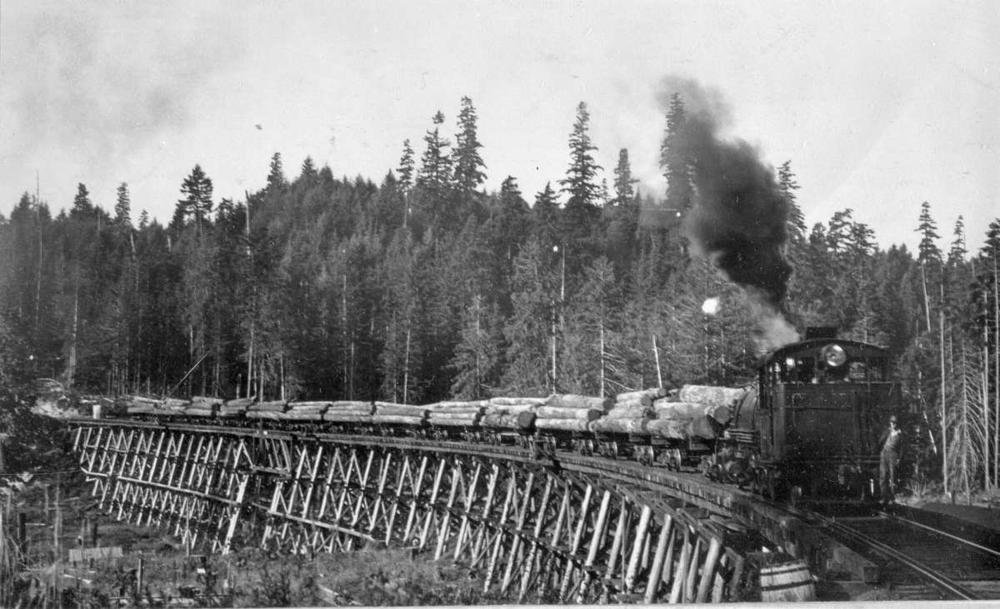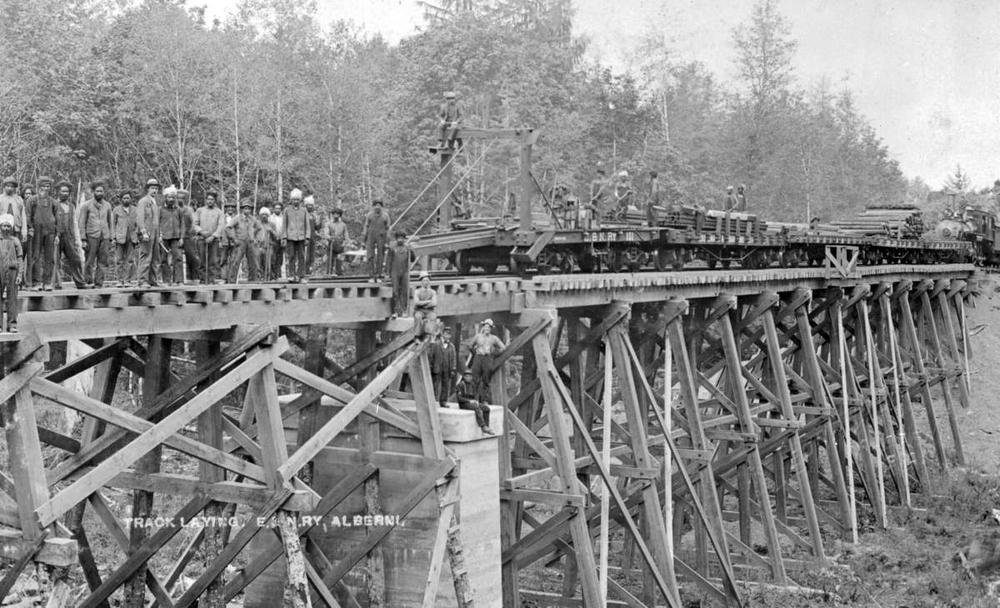
Work
Image Credit: Mike Ekers
The research asks how three large public sector pension plans have come to ‘own’ a massive amount of private, yet largely unceded, forested lands on Vancouver Island, the territory of numerous Coast Salish and Nuu-Chah-Nulth nations.
In 1887, a massive belt of land, 32 kilometres wide, starting near Sooke and running north to Campbell River, was granted to Esquimalt and Nanaimo Railway Company as payment for the construction of a 115-kilometre railway. This project traces financial ownership in the 21st century back to industrial ownership in the 20th century, and further to 19th century colonial Esquimalt and Nanaimo Railway (E&N) land grants.

The E & N Railway; Logging Train, Image E-00785 courtesy of the Royal BC Museum
Indigenous rights and title
The research asks how three large public sector pension plans have come to ‘own’ a massive amount of largely unceded, forested lands on Vancouver Island, the territory of numerous Coast Salish and Nuu-Chah-Nulth nations.
Indigenous nations have argued that there was no consultation, consent or compensation for the privatization of land within their territory. Coast Salish and Nuu-Chah-Nulth nations’ title to the land found within the land grant pre- and post-dates the enclosure of their territory that occurred with the establishment of fee-simple title in 1887. The architects of the deal, including colonialists such as Joseph Trutch, Robert Dunsmuir and Prime Minister MacDonald, disregarded earlier Crown acknowledgments of Aboriginal title, and pushed the railway deal through without any pretence for layers of title and deeply held Indigenous relationships to the land, both of which endure despite gates and security cameras meant to limit access to the territory.
These research takes inspiration from the political and legal work of Indigenous nations in relation to the E&N land grants and owners of private forest lands. We explore the knotted question of Aboriginal title on private land explore how communities have pushed back against private ownership and state policies specific to private land. The work seeks the elevate Indigenous legal traditions and court challenges and seeks to envision Indigenous-led governance of unceded, yet private land, and possibilities for reparations.

Image Credit: Mike Ekers
Forestry practices and policies
Layered overtop of the Indigenous territory found within the E&N belt, is an extractive settler forestry industry that dates back to the initial grant.
The E&N Railway Company quickly sold off valuable tracts of forests to timber companies. In the 20th century, Canadian Pacific Railway and then MacMillan Bloedel, Crown Zellerbach and other industrial forestry companies took control of the land. In the 21st century, in a profound period or restructuring, public sector pension plans acquired the land through their ownership of Island Timberlands and TimberWest.
The research explores the forestry practices and policies set in motion by the E&N land grants and the political economic relations that have driven changing ownership and management regimes. We question the exceptional status that private forest lands have been afforded by successive governments and connect this to the initial colonial land grants and their enduring legacies. The project interrogates how provincial governments and owners of private forest land have pointed to the E&N land grants as a means of limiting Indigenous access, consultation and ultimately control of territory.

Track Laying, E&N Railway, Alberni, Image F-06929 courtesy of the Royal BC Museum
Goals
The research hopes to provide a public and scholarly accounting of the E&N land grants and their significance for forestry policies and practices, Indigenous nations and the broader settler public who also deal with diminished access and the effects of deforestation.
We hope the research doubles as a resource for those engaged with the issue of private forest lands and for Indigenous nations navigating the legacies of the E&N land grants.

Image Credit: Mike Ekers
Team
This research is being undertaken by Estair Van Wagner (University of Victoria), Michael Ekers (University of Toronto), Sarah Morales (University of Victoria) and Brian Thom (University of Victoria) and a remarkable group of research assistants.